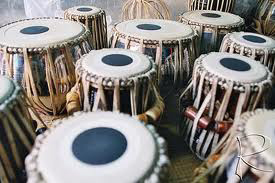Introduction tabla
"The arising, enduring and disappearance of the three worlds comes from rhythm (tala). From the worm onwards, all animals move by rhythm. All works in the world depend on rhythm. It is by rhythm that the sun and the planets move." (Quoted in Ragakalpa-druma, Calcutta 1842 [1] )
The tabla is played with both hands, with the left drum, the bayan or duggi, providing the melodic bass sounds. The bayan is made of copper or sometimes clay and covered with a goatskin. The right drum, the dayan with its characteristic high-resonance sounds, is also covered with a goatskin but is made of wood.
Very special about the Tabla and absolutely unique in the world is the "black dot", or in hindi, the shyahi, a mixture of very fine iron dust, mixed with dough or rice and a few other ingredients to form a kind of malleable paste. Very slowly, layer by layer (sometimes 20 to 30 layers in total) is rubbed into the skin with a stone until the overtones are clear and pure. This process often takes all day. We often see "black dots" on drums around the world, but they are mainly for dampening unwanted higher notes or for tuning the lower notes, as with the bayan. But in the case of the dayan, the shyahi has been developed in such a way that it can produce a rich variety of overtones, providing a highly variable tonal possibility. The combination of left and right hand sounds, played together or separately, gives the tabla and some other North Indian percussion instruments such a multitude of subtle sounds.
Since the emergence of the modern classical style, the khayal, about 250 years ago, the Tabla has become the most popular drum in North India. The tabla originates from the pakhawaj, the official accompaniment to the medieval musical dhrupad style. Some scholars argue that the tabla may have come from the kettle drums, the naggara, of the Moghul courts, or from the early Indian folk drums, the dukkar, which are also very similar to the tablas.[2] Variations of the name "tabla" can be found all over the world: in Africa, southern Russia and China to South America. The Arabic term "tabl" means drum in general, and all these terms are not always applied to the same kind of drum. [3]. Vertically cone-shaped drums appear in the visual arts of the 6th and 7th centuries [4]. It is certain that the tabla has undergone enormous changes, and its current form is no more than 70 to 100 years old.[5].
For more historical information in English, please see this link to Digitabla.com Digitabla: Tabla tradition and history

